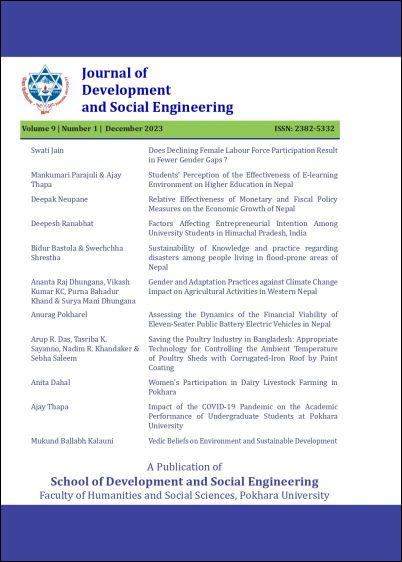Does Declining Female Labour Force Participation Result in Fewer Gender Gaps?
DOI:
https://doi.org/10.3126/jdse.v9i01.70551Keywords:
South Asia, Economic participation, gender inequality, panel regressionAbstract
South Asia has the second highest gender gap in8 major regions in the world. The highest gender gaps are for economic participation and political empowerment. Economic participation and opportunities grow as more women pursue professional and technical education. The over-all gender gap has marginally declined from 54.08 in 1998 to 50.8 in 2021. This indicate that the progress has been remarkably slow in terms of female labour force participation, with India, Pakistan, Afghanistan and Maldives on the lowest side. While South Asia is the fastest-growing region globally, the female labour force participation rate is only 23.6% versus 80% for men. There is a significant negative relationship between the two variables. With every increase in per capita income level in South Asia, labour force participation shows an inverted U relationship. This contradicts the empirical estimations in the literature showing a U shape relationship. The main finding is that gender gaps in employment, job characteristics, and working conditions are growing as per capita incomes rise. Further, per capita, income growth speeds up the reduction process of gender inequality and gender gaps. This again confirms the proposition that labour force participation does not directly lead to reduction in gender gaps. Reduction in gender gaps does lead to increased labour force participation. Effective implementation of gender-centric policies, creating a level playing field for women, accelerates the process of gender balanced opportunities and outcomes. Technological interventions cannot act as a substitute for policy interventions.
Downloads
Downloads
Published
How to Cite
Issue
Section
License
Copyright © Journal of Development and Social Engineering, School of Development and Social Engineering, Faculty of Humanities and Social Sciences, Pokhara University. All rights reserved. The School of Development and Social Engineering, Pokhara University holds the exclusive copyright of all the contents of this journal. No part of this journal may be reproduced or transmitted by any media or publishing organizations including websites without the written permission of the copyright holder. The contents of this journal are available for any citation, using a recognized and proper referencing system.




